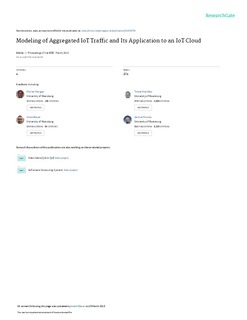| dc.contributor.author | Metzger, Florian | |
| dc.contributor.author | Hossfelt, Tobias | |
| dc.contributor.author | Bauer, André | |
| dc.contributor.author | Kounev, Samuel | |
| dc.contributor.author | Heegaard, Poul Einar | |
| dc.date.accessioned | 2019-12-05T06:55:58Z | |
| dc.date.available | 2019-12-05T06:55:58Z | |
| dc.date.created | 2019-02-12T18:23:49Z | |
| dc.date.issued | 2019 | |
| dc.identifier.citation | Proceedings of the IEEE. 2019, 107 (4), 679-694. | nb_NO |
| dc.identifier.issn | 0018-9219 | |
| dc.identifier.uri | http://hdl.handle.net/11250/2631823 | |
| dc.description.abstract | As the Internet of Things (IoT) continues to gain traction in telecommunication networks, a very large number of devices are expected to be connected and used in the near future. In order to appropriately plan and dimension the network, as well as the back-end cloud systems and the resulting signaling load, traffic models are employed. These models are designed to accurately capture and predict the properties of IoT traffic in a concise manner. To achieve this, Poisson process approximations, based on the Palm-Khintchine theorem, have often been used in the past. Due to the scale (and the difference in scales in various IoT networks) of the modeled systems, the fidelity of this approximation is crucial, as, in practice, it is very challenging to accurately measure or simulate large-scale IoT deployments. The main goal of this paper is to understand the level of accuracy of the Poisson approximation model. To this end, we first survey both common IoT network properties and network scales as well as traffic types. Second, we explain and discuss the Palm-Khintiche theorem, how it is applied to the problem, and which inaccuracies can occur when using it. Based on this, we derive guidelines as to when a Poisson process can be assumed for aggregated periodic IoT traffic. Finally, we evaluate our approach in the context of an IoT cloud scaler use case. | nb_NO |
| dc.language.iso | eng | nb_NO |
| dc.publisher | Institute of Electrical and Electronics Engineers (IEEE) | nb_NO |
| dc.title | Modeling of aggregated IoT traffic and its application to an IoT cloud | nb_NO |
| dc.type | Journal article | nb_NO |
| dc.type | Peer reviewed | nb_NO |
| dc.description.version | acceptedVersion | nb_NO |
| dc.source.pagenumber | 679-694 | nb_NO |
| dc.source.volume | 107 | nb_NO |
| dc.source.journal | Proceedings of the IEEE | nb_NO |
| dc.source.issue | 4 | nb_NO |
| dc.identifier.doi | 10.1109/JPROC.2019.2901578 | |
| dc.identifier.cristin | 1676621 | |
| dc.description.localcode | © 2019 IEEE. Personal use of this material is permitted. Permission from IEEE must be obtained for all other uses, in any current or future media, including reprinting/republishing this material for advertising or promotional purposes, creating new collective works, for resale or redistribution to servers or lists, or reuse of any copyrighted component of this work in other works. | nb_NO |
| cristin.unitcode | 194,63,30,0 | |
| cristin.unitname | Institutt for informasjonssikkerhet og kommunikasjonsteknologi | |
| cristin.ispublished | true | |
| cristin.fulltext | postprint | |
| cristin.qualitycode | 2 | |
